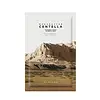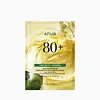What's inside
What's inside
 Key Ingredients
Key Ingredients

 Benefits
Benefits

 Ingredients Side-by-side
Ingredients Side-by-side

Centella Asiatica Extract
CleansingWater
Skin ConditioningDipropylene Glycol
HumectantGlycereth-26
HumectantGlycerin
Humectant1,2-Hexanediol
Skin ConditioningBetaine
HumectantButylene Glycol
HumectantPaeonia Suffruticosa Root Extract
Skin ProtectingPolyglyceryl-10 Laurate
Skin ConditioningChamomilla Recutita Flower Extract
MaskingGlyceryl Caprylate
EmollientCarbomer
Emulsion StabilisingXanthan Gum
EmulsifyingArginine
MaskingEthylhexylglycerin
Skin ConditioningSodium Hyaluronate
HumectantDextrin
AbsorbentTheobroma Cacao Extract
Skin ConditioningPropanediol
SolventCoptis Japonica Root Extract
Skin ConditioningMentha Arvensis Leaf Oil
MaskingSodium Hyaluronate Crosspolymer
HumectantHydrolyzed Glycosaminoglycans
HumectantBenzyl Glycol
SolventCentella Asiatica Extract, Water, Dipropylene Glycol, Glycereth-26, Glycerin, 1,2-Hexanediol, Betaine, Butylene Glycol, Paeonia Suffruticosa Root Extract, Polyglyceryl-10 Laurate, Chamomilla Recutita Flower Extract, Glyceryl Caprylate, Carbomer, Xanthan Gum, Arginine, Ethylhexylglycerin, Sodium Hyaluronate, Dextrin, Theobroma Cacao Extract, Propanediol, Coptis Japonica Root Extract, Mentha Arvensis Leaf Oil, Sodium Hyaluronate Crosspolymer, Hydrolyzed Glycosaminoglycans, Benzyl Glycol
Houttuynia Cordata Extract 80%
Skin ConditioningButylene Glycol
HumectantWater
Skin ConditioningDipropylene Glycol
Humectant1,2-Hexanediol
Skin ConditioningGlycerin
HumectantHydroxyacetophenone
AntioxidantCellulose Gum
Emulsion StabilisingCarbomer
Emulsion StabilisingAllantoin
Skin ConditioningPolyglyceryl-10 Laurate
Skin ConditioningCitric Acid
BufferingArginine
MaskingDisodium EDTA
Betaine
HumectantPanthenol
Skin ConditioningBiosaccharide Gum-1
HumectantTheobroma Cacao Extract
Skin ConditioningSodium Hyaluronate
HumectantDextrin
AbsorbentHydrolyzed Hyaluronic Acid
HumectantSodium Acetylated Hyaluronate
HumectantHouttuynia Cordata Extract 80%, Butylene Glycol, Water, Dipropylene Glycol, 1,2-Hexanediol, Glycerin, Hydroxyacetophenone, Cellulose Gum, Carbomer, Allantoin, Polyglyceryl-10 Laurate, Citric Acid, Arginine, Disodium EDTA, Betaine, Panthenol, Biosaccharide Gum-1, Theobroma Cacao Extract, Sodium Hyaluronate, Dextrin, Hydrolyzed Hyaluronic Acid, Sodium Acetylated Hyaluronate
 Reviews
Reviews

Ingredients Explained
These ingredients are found in both products.
Ingredients higher up in an ingredient list are typically present in a larger amount.
1,2-Hexanediol is a synthetic liquid and another multi-functional powerhouse.
It is a:
- Humectant, drawing moisture into the skin
- Emollient, helping to soften skin
- Solvent, dispersing and stabilizing formulas
- Preservative booster, enhancing the antimicrobial activity of other preservatives
Arginine is an amino acid that is important for human development. Your body uses is it to produce hair keratin and skin collagen.
As a cosmetic ingredient, Arginine has antioxidant properties and can also help repair damaged skin. This ingredient is derived either synthetically or from animals.
Arginine isn't fungal acne safe when used in the presence of other lipids (fats, fatty acids, oils, esters, etc). Oils and fats occur naturally within the skin, so take caution when using Arginine if you're prone to fungal acne.
Learn more about ArginineBetaine is a common humectant (a substance that promotes retention of moisture). It's known to be gentle on the skin and can help balance hydration.
This ingredient is best for improving hydration and soothing irritated skin. Studies also show it helps even out skin tone.
Fun fact: Betaine is naturally created in the skin and body. The kind found within cosmetic products can be either plant-derived or synthetic.
Another name for betaine is trimethylglycine.
Learn more about BetaineButylene Glycol (or BG) is used within cosmetic products for a few different reasons:
Overall, Butylene Glycol is a safe and well-rounded ingredient that works well with other ingredients.
Though this ingredient works well with most skin types, some people with sensitive skin may experience a reaction such as allergic rashes, closed comedones, or itchiness.
Learn more about Butylene GlycolCarbomer is a polymer of acrylic acid. Its main role is to create a gel consistency.
A high amount of carbomer can cause pilling or balling up of products. Don't worry, most products contain 1% or less of carbomer.
Dextrin is used to thicken a product and helps bind ingredients together. It is created from starch and glycogen.
As an emulsifier, dextrin prevents ingredients from separating. This helps elongate a product's shelf life.
Studies show coating UV filters with dextrin prevents these ingredients from being absorbed. This helps UV ingredients last longer on the skin.
Learn more about DextrinDipropylene Glycol is a synthetically created humectant, stabilizer, and solvent.
This ingredient helps:
Dipropylene glycol is technically an alcohol, but it belongs to the glycol family (often considered part of the ‘good’ alcohols). This means it is hydrating and gentle on skin unlike drying solvent alcohols like denatured alcohol.
As a masking agent, Dipropylene Glycol can be used to cover the smell of other ingredients. However, it does not have a scent.
Studies show Dipropylene Glycol is considered safe to use in skincare.
Learn more about Dipropylene GlycolGlycerin is already naturally found in your skin. It helps moisturize and protect your skin.
A study from 2016 found glycerin to be more effective as a humectant than AHAs and hyaluronic acid.
As a humectant, it helps the skin stay hydrated by pulling moisture to your skin. The low molecular weight of glycerin allows it to pull moisture into the deeper layers of your skin.
Hydrated skin improves your skin barrier; Your skin barrier helps protect against irritants and bacteria.
Glycerin has also been found to have antimicrobial and antiviral properties. Due to these properties, glycerin is often used in wound and burn treatments.
In cosmetics, glycerin is usually derived from plants such as soybean or palm. However, it can also be sourced from animals, such as tallow or animal fat.
This ingredient is organic, colorless, odorless, and non-toxic.
Glycerin is the name for this ingredient in American English. British English uses Glycerol/Glycerine.
Learn more about GlycerinPolyglyceryl-10 Laurate is an ester of lauric acid and Polyglycerin-10.
Polyglyceryl-10 Laurate is a cleansing agent and emulsifier. It helps gather dirt, oil, and other pollutants to be rinsed away. As an emulsifier, it helps prevent ingredients from separating, such as oil and water.
Polyglyceryl-10 Laurate may not be fungal acne safe.
Learn more about Polyglyceryl-10 LaurateSodium Hyaluronate is hyaluronic acid's salt form. It is commonly derived from the sodium salt of hyaluronic acid.
Like hyaluronic acid, it is great at holding water and acts as a humectant. This makes it a great skin hydrating ingredient.
Sodium Hyaluronate is naturally occurring in our bodies and is mostly found in eye fluid and joints.
These are some other common types of Hyaluronic Acid:
Learn more about Sodium HyaluronateThis ingredient is extracted from the seeds of the cocoa tree.
Cacao seeds contain antioxidants known as polyphenols. These include flavonoids, procyanidins, and epicatechins.
Studies show these polyphenols help improve skin health.
The more famous ingredient from cocoa tree is cocoa butter.
Learn more about Theobroma Cacao ExtractWater. It's the most common cosmetic ingredient of all. You'll usually see it at the top of ingredient lists, meaning that it makes up the largest part of the product.
So why is it so popular? Water most often acts as a solvent - this means that it helps dissolve other ingredients into the formulation.
You'll also recognize water as that liquid we all need to stay alive. If you see this, drink a glass of water. Stay hydrated!
Learn more about Water